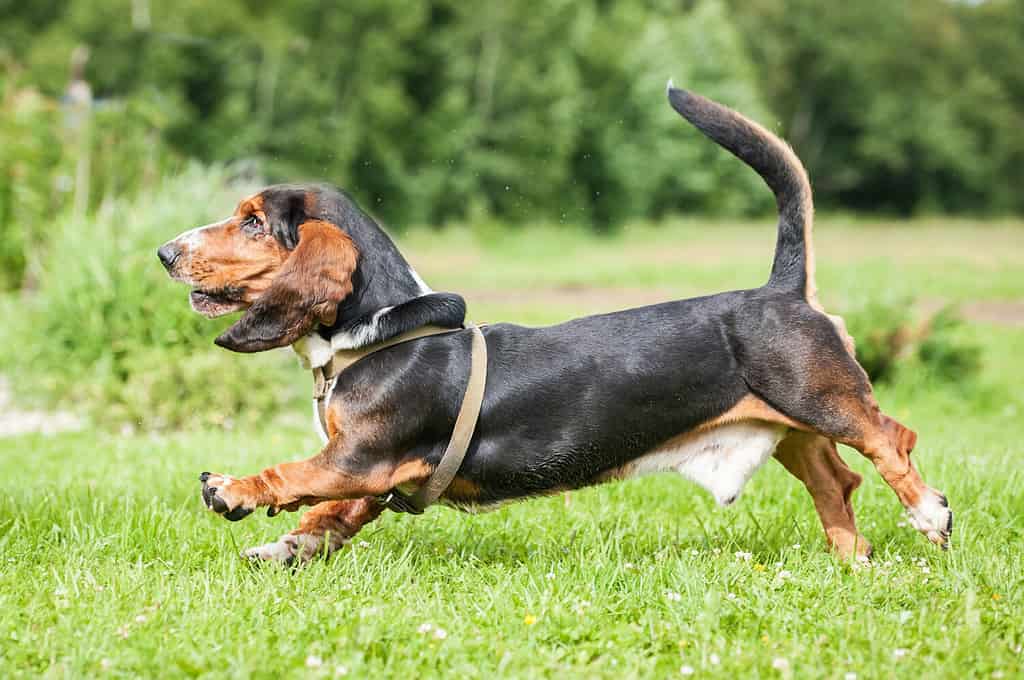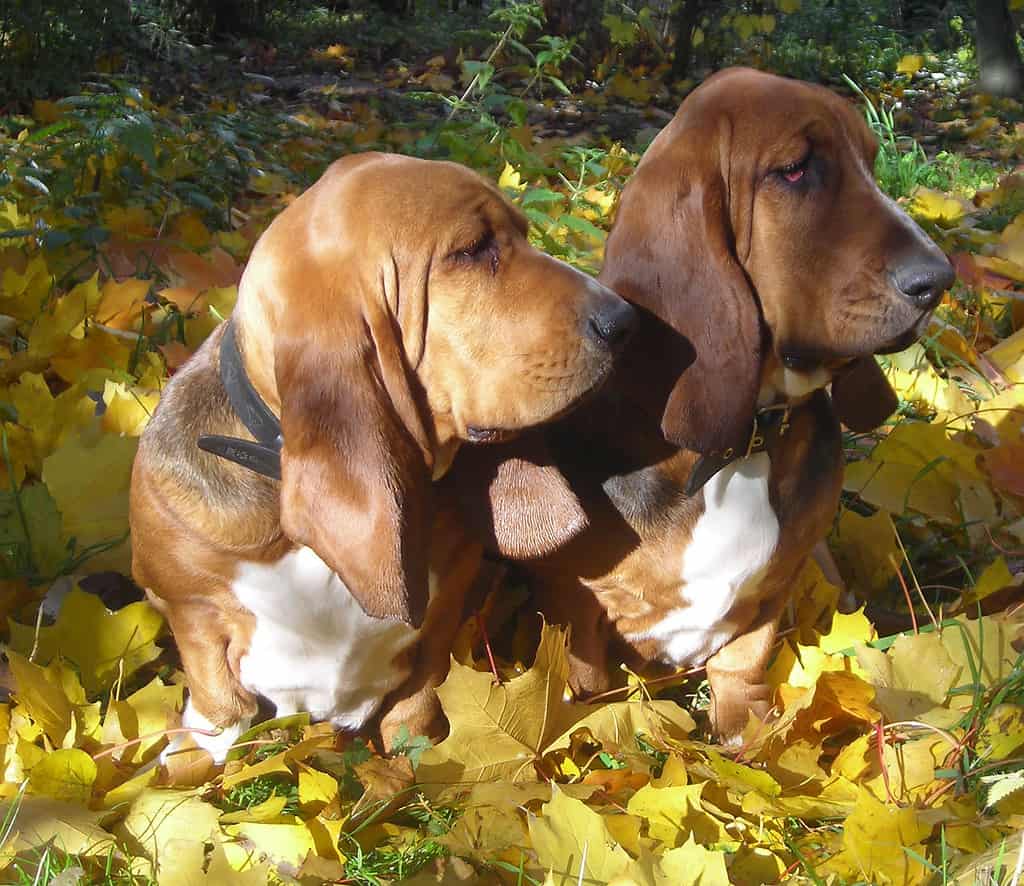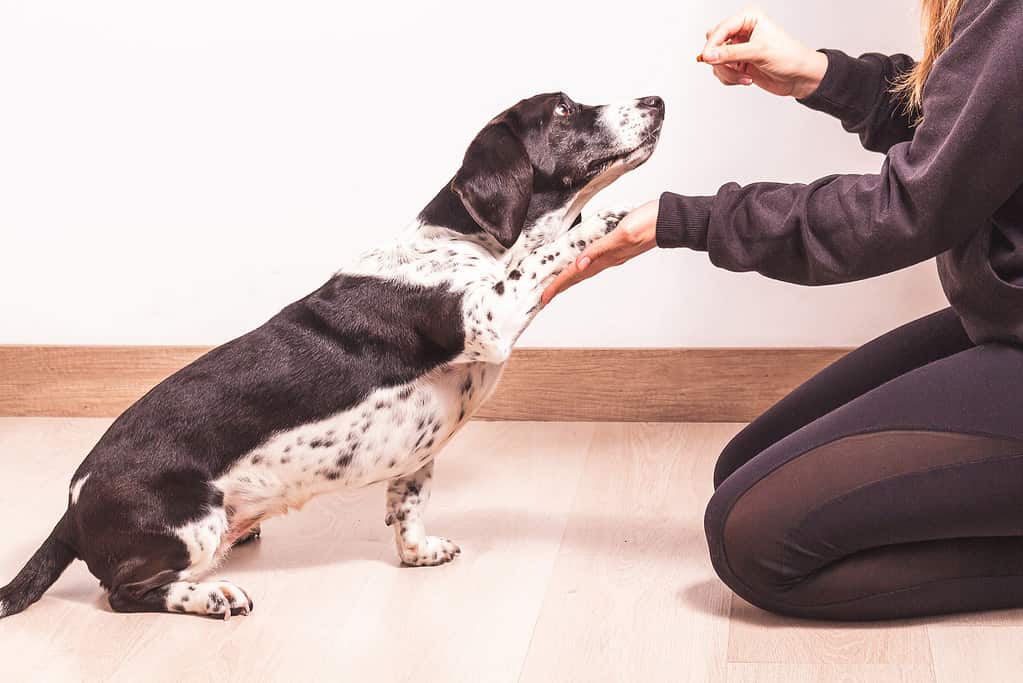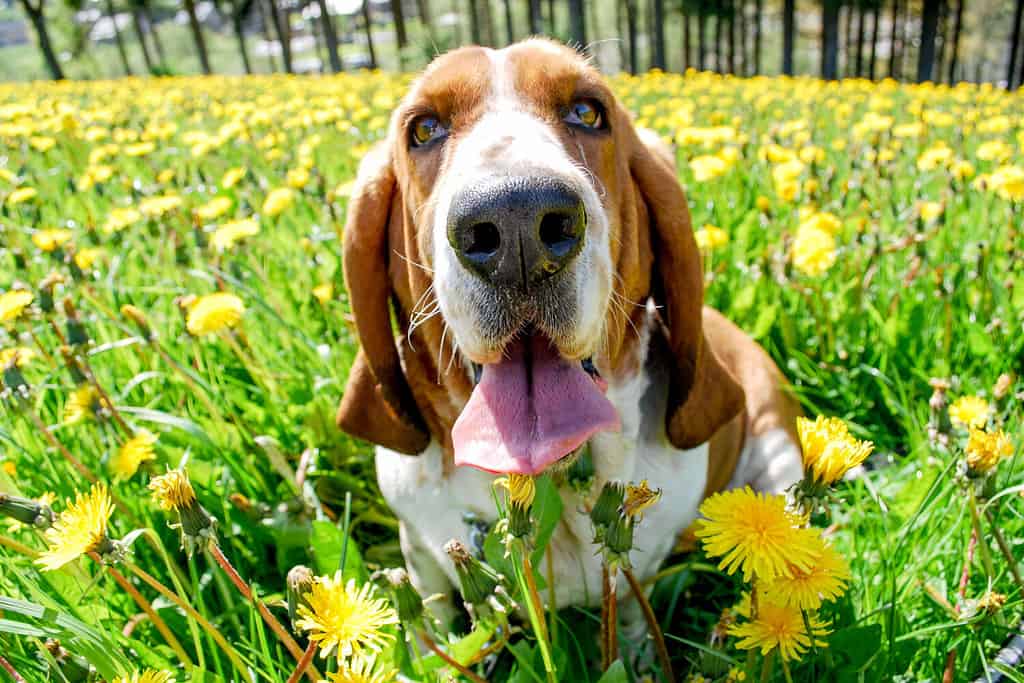Basset hounds may look absolutely adorable with their short, stubby legs. However, those short legs tend to cause the most significant Basset hound health problems. Simply put, Bassets are “deformed,” with their shorter legs technically caused by a genetic disorder (we just happened to breed for this genetic disorder).
These dogs can also develop other types of health problems, though. Some have a direct impact on their lifespan. We’ll take a look at all of the most common health problems in Basset Hounds below.
1. Hip and Elbow Dysplasia

Too much exercise can lead to joint issues in growing puppies. Don’t force your puppy to exercise.
©Rita_Kochmarjova/Shutterstock.com
Basset hounds are likelier to end up with hip and/or elbow dysplasia than other dogs. This condition occurs when the dog is growing. For one reason or another, the dog’s hip or elbow joints do not develop evenly, causing extra wear. This issue leads to arthritis-like symptoms at a pretty young age.
Sadly, this condition cannot be treated, though surgery is sometimes required to improve mobility. Often, it is treated similarly to arthritis.
This condition is partially genetic and partially environmental. How you feed your puppy matters a lot. Without the proper nutrients, your puppy won’t grow properly, which can lead to joint dysplasia. Be sure to feed your puppy a food formulated for puppies.
2. Spinal Conditions
Basset hounds have unusually small legs and a long back. In many cases, this deformity leads to spinal conditions developing. One of these conditions is intervertebral disc disease (IVDD), which can cause loss of mobility and even paralysis in some canines. Other conditions are also possible, such as hemivertebrae.
Often, obesity and overexercising can increase the odds and severity of all these issues. Therefore, it’s important to keep your dog at a healthy weight and avoid activities that might strain their back, such as excess jumping.
3. Wobbler Syndrome

Because wobbler syndrome is genetic, careful breeding can prevent it. Be sure to choose your puppy from a quality breeder.
©Сварта Пим / Public domain – License
Wobbler syndrome is a neurological condition that is genetic. It causes the basset hound to have a wobbly gait, hence the name. This condition occurs because the vertebrae in the neck narrow, limiting the spinal cord’s ability to carry messages to and from the brain. This issue leads to a loss of feeling, so your dog likely won’t be able to walk as well as others.
Treatment is possible, but many dogs will continue to have some issues for the rest of their lives. Medication and surgery are often the biggest treatment options.
4. Bloat
While it sounds benign, bloat isn’t your Basset hound simply eating too much. Instead, this condition occurs when the stomach fills with gas and (sometimes) twists. Left untreated, this condition causes the stomach to swell to dangerous proportions. It will push up against your dog’s abdominal cavity walls, cutting off blood flow.
This condition is always fatal if left untreated, and treatment involves surgery. Sometimes, bloat can progress very quickly, causing a fatality in less than 30 minutes. Therefore, it’s important to seek treatment right away.
5. Dilated Cardiomyopathy

Sometimes, dilated cardiomyopathy is diet-related. Therefore, adding supplements is sometimes helpful.
©Fabian Ponce Garcia/Shutterstock.com
Basset hounds are prone to dilated cardiomyopathy, which occurs when the heart becomes enlarged and weakened. It has a harder time pumping blood effectively, leading to even more enlargement. Often, DCM is progressive, meaning it gets worse over time.
Common signs of this condition include fatigue, labored breathing, and coughing. However, DCM commonly causes no signs at all. Luckily, when caught early, this condition can be controlled with dietary supplements and medication.
DCM is sometimes caused by a lack of taurine in a dog’s diet. In this case, the condition may correct itself when the nutrient is added to your dog’s food.
6. Addison’s Disease
This endocrine condition occurs when the body’s adrenal glands do not function properly. The adrenal glands produce hormones that keep the body running correctly. Without enough of the adrenal hormones, your do will eventually pass away. However, diagnosing this condition is often challenging because the signs can mirror many other health problems.
Luckily, there are now blood tests that can identify Addison’s disease. Therefore, it is much easier to treat today. In most cases, this condition can be controlled with medication that replaces the adrenal hormones.
7. Von Willebrand’s Disease

Some vets recommend testing dogs for this condition before they are spayed or neutered.
©praneem79/Shutterstock.com
This blood clotting disorder prevents your dog’s blood from clotting as it normally would. Therefore, your dog will bleed more, which is potentially fatal. Von Willebrand’s disease does come in different levels of severity. Some dogs may have it, but it may be so minor that it’s never noticed. However, other dogs may have much more severe bleeding.
This condition also comes in various “types.” Basset hounds can get two of these types – one that is always severe and another that varies in severity.
Often, this condition goes unnoticed until the dog’s routine spay or neuter surgery. At that point, the dog may bleed excessively and clue the vet into the dog’s condition. No cure is available for all dogs. However, some with very mild varieties may respond to medication. Others must be treated with blood transfusions during a severe bleeding episode.
8. Hemangiosarcoma
While this condition is rare, it does seem to occur in Basset hounds more often than in other dogs. As you might guess from the name, hemangiosarcoma is a “bleeding tumor.” Usually, these tumors end up on the spleen, but they can technically end up on any organ.
This condition occurs when the tumor breaks open and causes internal bleeding. Often, this goes undiagnosed for some time. However, the tumor will continue growing, and eventually, signs of the tumor’s existence appear.
Some vets may recommend senior Basset hounds get screened during their yearly examination. Often, a blood test can provide clues that a bleeding tumor is present.
9. Eosinophilic Panosteitis

Due to their very long back, this breed is prone to all sorts of skeletal conditions.
©GoDog Photo/Shutterstock.com
While “eosinophilic panosteitis” can sound scary, this condition is mostly benign. It refers to inflammation of the Basset’s long bones in their legs, which causes pain. Often, it starts around six to ten months of age. It may come and go. Usually, it doesn’t occur in all four legs simultaneously, but it may move from leg to leg.
In many cases, the dog will be in obvious pain. They may not want to walk much or be touched in the tender area. An X-ray can confirm the diagnosis by showing the inflammation.
Luckily, this condition doesn’t cause permanent damage. There isn’t actually anything wrong with a dog’s leg. The pain can be treated with anti-inflammatory and pain medication.
However, if left untreated, some dogs do start walking strangely to compensate for their sore leg. Even after correction, these dogs may still walk weirdly and may require rehabilitation exercises.
10. Kidney and Bladder Stones
Sadly, bladder stones are more common in Basset hounds than other dogs. While these stones are painful, they are often undetected by dog owners unless they become very serious. However, a quick urine test by a vet can pick up on these stones easily.
Sometimes, medication is needed to prevent stones in dogs that seem particularly prone to them. Other times, a dietary change may be recommended. Surgery is sometimes needed to remove larger bladder stones.
While stones are often not life-threatening, they can be if the passage of urine is blocked. If your Basset hound cannot urinate, it is a medical emergency.
11. Patellar Luxation

Keep an eye on how your dog walks to diagnose patellar luxation before it causes serious damage to the knee joint.
©Mindaugas Dulinskas/iStock via Getty Images
Patellar luxation is most common in smaller dogs, including Basset hounds. It causes the kneecap to move out of position over and over again. When caught, it can be treated with surgery. However, it’s sadly often not diagnosed, and the constant rubbing causes wear and arthritis.
Often, your dog may limp or do the characteristic “bunny hop” when their kneecap is sliding. If you notice these signs, veterinary attention is recommended. It’s much easier to treat this condition upfront with surgery than to control arthritis and pain for the rest of the dog’s life.
The photo featured at the top of this post is © iStock.com/GlobalP
Ready to discover the top 10 cutest dog breeds in the entire world?
How about the fastest dogs, the largest dogs and those that are -- quite frankly -- just the kindest dogs on the planet? Each day, AZ Animals sends out lists just like this to our thousands of email subscribers. And the best part? It's FREE. Join today by entering your email below.
Thank you for reading! Have some feedback for us? Contact the AZ Animals editorial team.






